SUBFAMILY PONERINAE
(Lepeletier de Saint-Fargeaux, 1835: 185)
| The Ants of
Africa SUBFAMILY PONERINAE (Lepeletier de Saint-Fargeaux, 1835: 185) |
|
| Contents - Ponerinae |
Diagnostic Features - Pedicel of a single segment, with a narrow connection to the gaster (the helcium) so that the petiole has a distinct posterior face. Eyes usually present; clypeus well developed so that the antennal insertions are some distance behind the anterior margin of the head. Genae usually not carinate. Frontal carinae at least partially cover the antennal insertions, forming simple short semicircles or blunt trinagles. Pygidium never impressed or armed with spines or denticles. Alitrunk dorsally usually with at least one suture.
Status revised by Bolton (2003: 7, 42, 156), with separation of
(now) Subfamily
Amblyoponinae (Genera Amblyopone, Concoctio, Mystrium
and Prionopelta) and Subfamily Proceratiinae
(Genera Discothyrea, Proceratium and Probolomyrmex).
Further changes come from the work of Schmidt & Shattuck (2014) who
revised the higher classification of the subfamily. In particular
they reverted the membership of Pachycondyla to the situation
essentially prior to the publication of Bolton (1995). The revived
African genera in the Schmidt & Shattuck list are Bothroponera Mayr; Brachyponera Emery;
Euponera Forel; Hagensia Forel; Megaponera Mayr; Mesoponera Emery; Ophthalmopone Forel; and Paltothyreus Mayr. They defined two new genera, Fisheropone Schmidt & Shattuck and Parvaponera Schmidt & Shattuck. There now are no known African Pachycondyla F. Smith. Schmidt & Shattuck (2014: Fig. 48) map "exotic" presence of unnamed Genus Ponera
Latreille, in Gabon and South Africa but cite Bolton & Fisher (2011) as reporting no definitive records. Antweb - see http://www.antweb.org/specimenImages.do?code=casent0900367 (accessed 27.vi.2014) show a worker of Ponera swezeyi from Zanzibar but no Ponera from Gabon or South Africa.
Bolton & Brown (2002) formally describing the new Genus Loboponera, have grouped three Afrotropical genera, Plectroctena, Psalidomyrmex and Loboponera as having a common "autapomorphic" development in workers and queens, i.e. "the anteroventral articulatory surface of the petiole being long and very broad, the surface with a narrow median V-shaped longitudinal groove or central small pore-like depression".
In essence the following key (derived in part from Bolton, 1994) was posted by me long before the on-line publication of Bolton, B. & Fisher, B.L. 2008c. Afrotropical ants of the ponerine genera Centromyrmex Mayr, Promyopias Santschi gen. rev. and Feroponera gen. n., with a revised key to genera of African Ponerinae (Hymenoptera: Formicidae). Zootaxa, 1929, 1-37 - weblink - http://www.mapress.com/zootaxa/2008/f/z01929p037f.pdf [10 Nov. 2008]
Illustrated Key to Ponerine genera of Africa
| 1 | 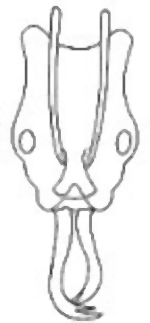 Mandible long and linear, in
full-face view inserted in the middle of the anterior margin of the
head, with an apical armament of 3 teeth arranged in a vertical series Mandible long and linear, in
full-face view inserted in the middle of the anterior margin of the
head, with an apical armament of 3 teeth arranged in a vertical series |
2 |
| -- |  Mandible
linear to triangular, in full-face view inserted
at the anterolateral corner of the head and not armed apically with a
vertical series of teeth Mandible
linear to triangular, in full-face view inserted
at the anterolateral corner of the head and not armed apically with a
vertical series of teeth |
3 |
| 2 | 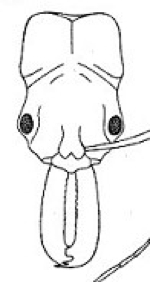 Nuchal
carina (separating dorsal from posterior surfaces of head) converging
in a V at the midline, and also receiving a pair of prominent, dark,
posterior apophyseal lines that converge to form the sharp
median-dorsal groove of the vertex; dorsalmost tooth of apical
mandibular series truncated; large species (TL > 10mm). Nuchal
carina (separating dorsal from posterior surfaces of head) converging
in a V at the midline, and also receiving a pair of prominent, dark,
posterior apophyseal lines that converge to form the sharp
median-dorsal groove of the vertex; dorsalmost tooth of apical
mandibular series truncated; large species (TL > 10mm). |
Odontomachus |
| -- | 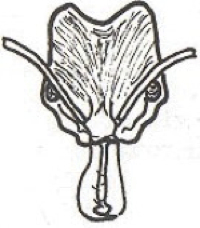 Nuchal
carina forming a broad, uninterrupted curve across the posterodorsal
extremity of the head; posterior surface without paired, dark
apophyseal lines; on vertex the median groove absent or ill-defined and
shallow; dorsalmost tooth of apical mandibular series acute; relatively
small (TL rarely more than 6 mm). Nuchal
carina forming a broad, uninterrupted curve across the posterodorsal
extremity of the head; posterior surface without paired, dark
apophyseal lines; on vertex the median groove absent or ill-defined and
shallow; dorsalmost tooth of apical mandibular series acute; relatively
small (TL rarely more than 6 mm). |
Anochetus |
| 3 |  Dorsal
(outer) surfaces of middle tibiae and middle and hind basitarsi
equipped with numerous strong cuticular spines or peg-like teeth which
are very conspicuous Dorsal
(outer) surfaces of middle tibiae and middle and hind basitarsi
equipped with numerous strong cuticular spines or peg-like teeth which
are very conspicuous |
4 |
| -- | Ventral apex of hind tibia, when viewed from in front with the femur at right angle to the body, with two spurs, consisting of a large, pectinate spur and a second, smaller spur in front of the main spur in the direction of observation | 6 |
| 4 | 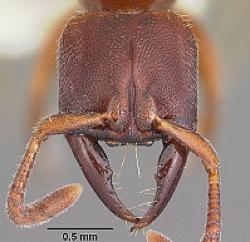 Mandibles
elongated with apical set of 3-4 small teeth; TL 5 mm; red brown, head,
mandibles and funiculi darker Mandibles
elongated with apical set of 3-4 small teeth; TL 5 mm; red brown, head,
mandibles and funiculi darker |
Promyopias |
| -- | Mandibles triangular to elongate-triangular, apex without a set of 3-4 small teeth | 5 |
| 5 | 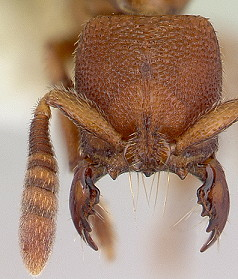 Antennae
with a distinct 4-segmented club; mandibles subtriangular, short and
stout, with 5 teeth; the apical tooth much the largest, curved and
acute so that the mandibles cross when closed; anterior clypeal margin
on each side with a broadly triangular tooth projecting over the base
of the closed mandibles; palp formula 2,3 Antennae
with a distinct 4-segmented club; mandibles subtriangular, short and
stout, with 5 teeth; the apical tooth much the largest, curved and
acute so that the mandibles cross when closed; anterior clypeal margin
on each side with a broadly triangular tooth projecting over the base
of the closed mandibles; palp formula 2,3 |
Feroponera |
| -- | 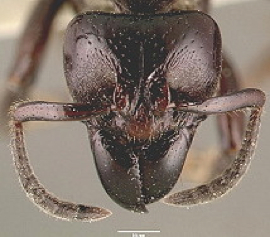 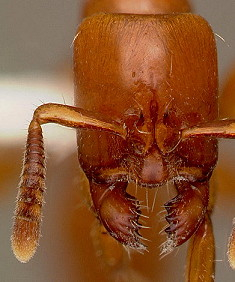 Antennal funiculus
increasing from base to apex but
without a distinct club Antennal funiculus
increasing from base to apex but
without a distinct club |
Centromyrmex |
| 6 | Ventral apex of hind tibia, when viewed from in front with the femur at right angle to the body, with a single, large, pectinate spur; without a second, smaller spur in front of the main spur in the direction of observation. | 7 |
| -- | Ventral apex of hind tibia, when viewed from in front with the femur at right angle to the body, with two spurs, consisting of a large, pectinate spur and a second, smaller spur in front of the main spur in the direction of observation | 15 |
| . | Ventral apex of hind tibia with a single large, pectinate spur | -- |
| 7 |  Mandible
elongate, linear, and weakly curved, blunt apically, the inner margin
with 0-2 blunt teeth; mandibular articulation associated with a marked
semicircular excavation of the dorsal anterior margin of the head in
front of the eyes Mandible
elongate, linear, and weakly curved, blunt apically, the inner margin
with 0-2 blunt teeth; mandibular articulation associated with a marked
semicircular excavation of the dorsal anterior margin of the head in
front of the eyes |
Plectroctena |
| -- | 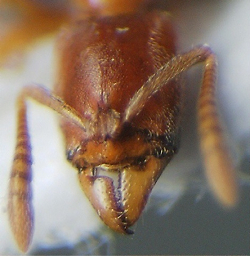 Mandible
triangular to elongate-triangular and with a sharp apical tooth, the
apical (masticatory) margin sometimes edentate but usually with several
to many teeth; mandibular articulation not associated with a
semicircular excavation of the dorsal anterior margin of the head in
front of the eyes Mandible
triangular to elongate-triangular and with a sharp apical tooth, the
apical (masticatory) margin sometimes edentate but usually with several
to many teeth; mandibular articulation not associated with a
semicircular excavation of the dorsal anterior margin of the head in
front of the eyes |
8 |
| 8 |  Basal
portion of mandible with a distinct circular or near-circular pit or
fovea dorsolaterally Basal
portion of mandible with a distinct circular or near-circular pit or
fovea dorsolaterally |
Cryptopone |
| -- | Basal portion of mandible without a dorsolateral pit or fovea | 9 |
| 9 |  Gaster
in profile and in dorsal view with a distinct impression or girdling
constriction between the first and second segments Gaster
in profile and in dorsal view with a distinct impression or girdling
constriction between the first and second segments |
10 |
| -- |  Gaster
in profile and in dorsal view without an impression or girdling
constriction between the first and second segments Gaster
in profile and in dorsal view without an impression or girdling
constriction between the first and second segments |
Asphinctopone |
| 10 | 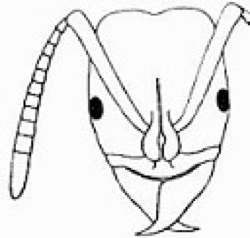 Mandible
elongate-falcate, with an extremely long apical tooth so that the tips
cross over at rest. Apical (masticatory) margin edentate or crenulate;
labrum prominent, in dorsal view projecting beyond the anterior clypeal
margin as a striated lobe; palp formula 3,4; larger ants, total length
9-16 mm Mandible
elongate-falcate, with an extremely long apical tooth so that the tips
cross over at rest. Apical (masticatory) margin edentate or crenulate;
labrum prominent, in dorsal view projecting beyond the anterior clypeal
margin as a striated lobe; palp formula 3,4; larger ants, total length
9-16 mm |
Psalidomyrmex |
| -- |  Mandibles
otherwise; short and triangular, lacking an extremely long apical
tooth, or, quite narrow and elongate; inner (masticatory) margin
multidentate; labrum not projecting beyond clypeus as a striated lobe
in dorsal view; palp formula less than 3,4 (unknown in Dolioponera);
smaller ants, total length less than 6 mm Mandibles
otherwise; short and triangular, lacking an extremely long apical
tooth, or, quite narrow and elongate; inner (masticatory) margin
multidentate; labrum not projecting beyond clypeus as a striated lobe
in dorsal view; palp formula less than 3,4 (unknown in Dolioponera);
smaller ants, total length less than 6 mm |
11 |
| 11 | 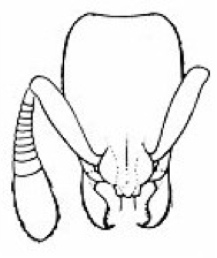 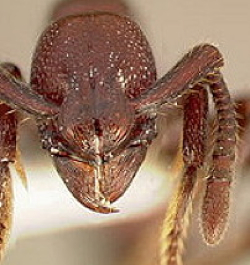 Frontal lobes
massive, projecting anteriorly and
overlapping the clypeus Frontal lobes
massive, projecting anteriorly and
overlapping the clypeus |
12 |
| -- |  Frontal
lobes small, not projecting anteriorly and not overlapping the clypeus Frontal
lobes small, not projecting anteriorly and not overlapping the clypeus |
14 |
| 12 | 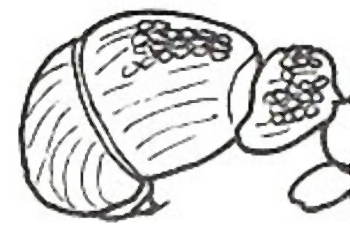 Second
gastral segment arched and downcurved posteriorly, the dorsum vaulted;
sternite of second gastral segment with a bluntly U-shaped outline in
profile, much smaller than the tergite; second gastral segment not much
larger than the first. Second
gastral segment arched and downcurved posteriorly, the dorsum vaulted;
sternite of second gastral segment with a bluntly U-shaped outline in
profile, much smaller than the tergite; second gastral segment not much
larger than the first. |
13 |
| -- |  Second
gastral segment barrel-shaped and longitudinal, the dorsum not vaulted,
not arched and downcurved posteriorly; sternite of second gastral
segment longitudinal, without a bluntly U-shaped outline in profile,
only slightly smaller than the tergite; second gastral segment very
much larger than the first; basal angle of mandible evenly rounded, the
apical (masticatory) margin with 8 teeth Second
gastral segment barrel-shaped and longitudinal, the dorsum not vaulted,
not arched and downcurved posteriorly; sternite of second gastral
segment longitudinal, without a bluntly U-shaped outline in profile,
only slightly smaller than the tergite; second gastral segment very
much larger than the first; basal angle of mandible evenly rounded, the
apical (masticatory) margin with 8 teeth |
Dolioponera |
| 13 |  Basal
angle of mandible angulate, the apical (masticatory) margin with fewer
than 8 teeth Basal
angle of mandible angulate, the apical (masticatory) margin with fewer
than 8 teeth |
Loboponera |
| -- | 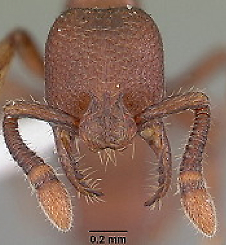 Mandible
narrow and elongated, without obtuse basal angle Mandible
narrow and elongated, without obtuse basal angle |
Boloponera |
| 14 |  Subpetiolar
process in profile with a bifurcate acute angle posteroventrally and with a
fenestra or translucent thin spot anteriorly Subpetiolar
process in profile with a bifurcate acute angle posteroventrally and with a
fenestra or translucent thin spot anteriorlyBolton & Fisher (2011) noted that there are no reliable reports from sub-Saharan Africa. |
Ponera |
| -- |  Subpetiolar
process in profile a simple lobe, rarely with an acute posteroventral
angle; most but not all lack an anterior fenestra or thin spot. Subpetiolar
process in profile a simple lobe, rarely with an acute posteroventral
angle; most but not all lack an anterior fenestra or thin spot.Bolton & Fisher (2011) have "posteriorly bifurcated ventral surface to the petiole sternite and the posteroventral apex of the subpetiolar process is never produced into a pair of sharp teeth that represent the apices of the bifurcation" |
Hypoponera |
| Ventral apex of hind tibia with two spurs, consisting of a large, pectinate spur and a second, smaller spur in front of the main spur | -- | |
| 15 | Pretarsal claws of middle and hind legs armed on the inner curvature with a tooth, either close to the midlength or near the base, or the entire inner curvature dentate to pectinate | 16 |
| -- | Pretarsal claws of middle and hind legs simple, the inner curvature without a tooth medially or near the base, never dentate or pectinate | 18 |
| 16 | 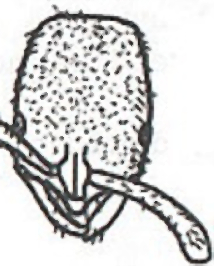 Pretarsal
claws of middle and hind legs pectinate or with 1-3 small teeth behind
the apex. If only 1 preapical tooth present on claw then mandible with
only 1-3 teeth and clypeus with a sharp, median longitudinal carina Pretarsal
claws of middle and hind legs pectinate or with 1-3 small teeth behind
the apex. If only 1 preapical tooth present on claw then mandible with
only 1-3 teeth and clypeus with a sharp, median longitudinal carina |
Leptogenys (part) |
| -- |  Pretarsal claws of middle and hind legs never pectinate,
the claws always with only a single preapical tooth. Mandible usually
with more than 3 teeth but may be edentate, in which case the clypeus
without a median longitudinal carina Pretarsal claws of middle and hind legs never pectinate,
the claws always with only a single preapical tooth. Mandible usually
with more than 3 teeth but may be edentate, in which case the clypeus
without a median longitudinal carina |
17 |
| 17 | 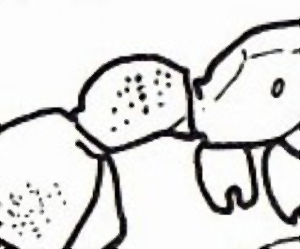 Helcium
located approximately at midheight on the front of the first gastral
segment so that the first gastral segment does not have a long,
vertical anterior face in profile. Tibiae of middle and hind legs each
with 2 pectinate spurs. Sculpture universally of fine, dense
shagreening with associated larger punctures. Eyes never positioned
well behind the midlength of the sides of the head Helcium
located approximately at midheight on the front of the first gastral
segment so that the first gastral segment does not have a long,
vertical anterior face in profile. Tibiae of middle and hind legs each
with 2 pectinate spurs. Sculpture universally of fine, dense
shagreening with associated larger punctures. Eyes never positioned
well behind the midlength of the sides of the head |
Platythyrea |
| -- | 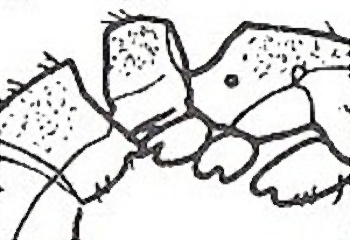 Helcium located
very low on the front of the first gastral
segment so that the first gastral segment has a long, vertical anterior
face in profile. Tibiae of middle and hind legs each with 1 large,
pectinate spur and 1 small, simple spur. Sculpture usually not of fine,
dense shagreening with associated larger punctures, but if such is
present then the eyes are positioned a considerable distance behind the
midlength of the sides of the head Helcium located
very low on the front of the first gastral
segment so that the first gastral segment has a long, vertical anterior
face in profile. Tibiae of middle and hind legs each with 1 large,
pectinate spur and 1 small, simple spur. Sculpture usually not of fine,
dense shagreening with associated larger punctures, but if such is
present then the eyes are positioned a considerable distance behind the
midlength of the sides of the head |
Pachycondyla (former Megaponera and Paltothyreus) |
| Pretarsal claws of middle and hind legs simple | -- | |
| 18 |  Petiole
dorsally with a comb of 5 long spines, which curve backwards over the
base of the first gastral segment Petiole
dorsally with a comb of 5 long spines, which curve backwards over the
base of the first gastral segment |
Phrynoponera |
| -- | Petiole dorsally without a comb of 5 spines | 19 |
| 19 | 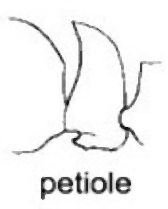 Sides of
petiole converging dorsally into a sharp,
longitudinal crest, which runs the length of the segment.
Posterolateral margins of petiole also sharply angulate in the dorsal
half, these sharp angles meeting the dorsal crest at its posterior end.
Anterior clypeal margin broadly concave, the concavity terminating at
each side in a prominent angle or tooth-like projection Sides of
petiole converging dorsally into a sharp,
longitudinal crest, which runs the length of the segment.
Posterolateral margins of petiole also sharply angulate in the dorsal
half, these sharp angles meeting the dorsal crest at its posterior end.
Anterior clypeal margin broadly concave, the concavity terminating at
each side in a prominent angle or tooth-like projection |
Streblognathus |
| -- | Petiole scale-like to nodiform but without a sharp, longitudinal crest running the length of the dorsum. Clypeus usually prominent but if shallowly concave medially then the concavity not terminating in prominent angles or teeth | 20 |
| 20 |  Mandible
armed with only 1-3 teeth (usually 2) Mandible
armed with only 1-3 teeth (usually 2) |
Leptogenys (part) |
| -- |  Mandible
armed with 5 or more teeth Mandible
armed with 5 or more teeth |
Pachycondyla (part) |
|
©2007, 2008, 2012, 2014 - Brian Taylor CBiol FSB FRES 11, Grazingfield, Wilford, Nottingham, NG11 7FN, U.K. |
href="ponerinae.htm"